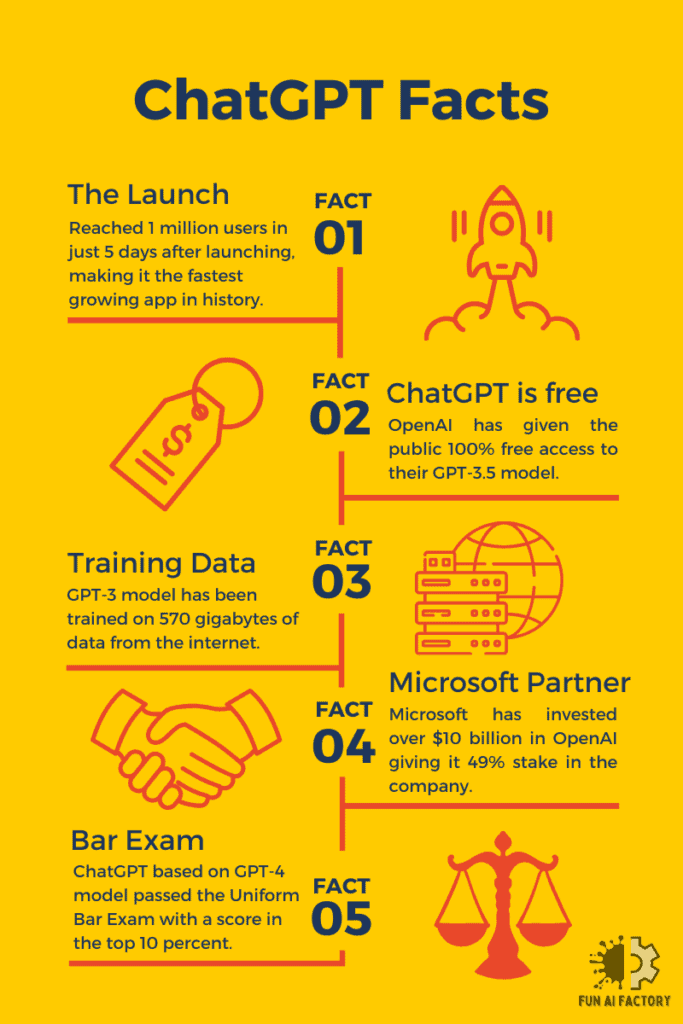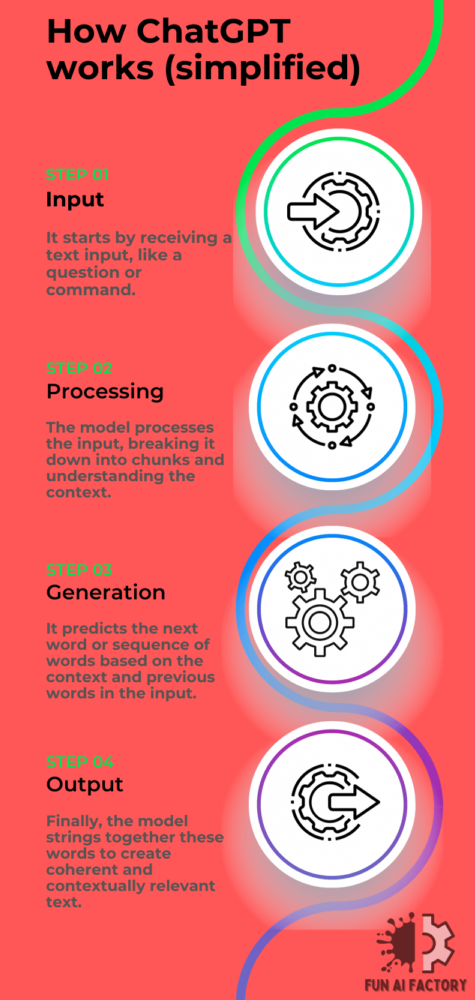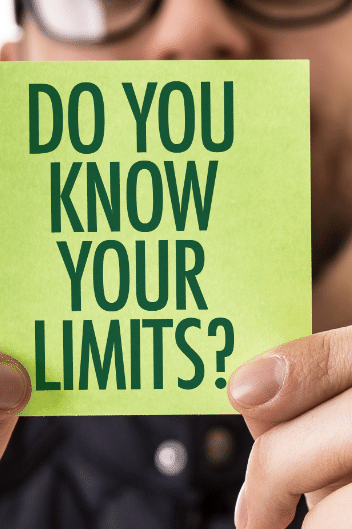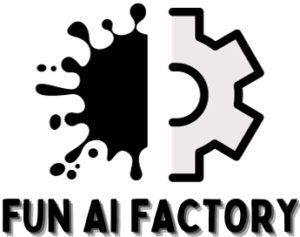Wondering what all the hype with ChatGPT is about? Read on to learn more.
ChatGPT is an advanced Artificial Intelligence (AI) language model launched on November 30, 2022 by OpenAI, based on the Generative Pre-trained Transformer (GPT) architecture. It utilizes deep learning techniques to understand and generate human-like conversational dialogue. Whether you’re a blogger looking to generate content, a developer aiming to integrate smart AI into applications, or merely a curious tech enthusiast, ChatGPT has something for you.

What can ChatGPT be used for?
Here are 18 ways in which people are using ChatGPT:
- Write computer programs and troubleshoot code
- Compose music
- Draft emails
- Summarize articles, podcasts or presentations
- Brainstorm ideas quickly like which title to go with for an article
- Solve math problems
- Find keywords and integrate them within your content for Search Engine Optimization (SEO)
- Lightening fast content creation such as articles, e-books, video scripts and social media posts
- Repurpose existing content for a different medium, such as convert a series of articles to create a script for YouTube videos
- Formulate product descriptions
- Play games against ChatGPT
- Helps to streamline job hunting process, including writing resumes and cover letters
- Describe complex topics in layman’s terms using metaphors and analogies
- Research markets for products
- Generate art
- Get personalized guidance in various domains including relationships, health & fitness, financial and work related
- Create content in multiple languages
- Simulate a job interview
In conclusion, ChatGPT isn’t just a technological marvel; it’s a canvas of endless opportunities. Its role in modern technology is profound, with applications stretching across industries and domains. The possibilities for monetization add to its allure, making it not just a tool but a venture waiting to be explored.
Who owns ChatGPT?
ChatGPT is a product of OpenAI, a research institution focused on artificial intelligence. Established in 2015, the organization was co-founded by noteworthy individuals such as Sam Altman, Elon Musk, Trevor Blackwell, Ilya Sutskever, Jessica Livingston, Andrej Karpathy, Greg Brockman, Wojciech Zaremba, and John Schulman.
As the incumbent CEO of OpenAI, Sam Altman is widely recognized as a key driving force behind the success of ChatGPT.
What does ChatGPT stand for?
The name ChatGPT comes from Chat Generative Pre-trained Transformer. GPT models are neural networks based on the transformer architecture that belong to a category of AI called generative artificial intelligence. Generative AI typically learn patterns from their input training data and are multimodal (capable of accepting inputs and generating outputs in text, images, and other media)
How does ChatGPT work?
ChatGPT works through a fascinating blend of algorithms and neural networks. It’s trained on vast amounts of text data, allowing it to predict and generate human-like responses. Here’s a simplified breakdown:
1. Input: It starts by receiving a text input, like a question or command.
2. Processing: The model processes the input, breaking it down into chunks and understanding the context.
3. Generation: It predicts the next word or sequence of words based on the context and previous words in the input.
4. Output: Finally, the model strings together these words to create coherent and contextually relevant text.

A paper called “Attention Is All You Need” published in 2017, introduced the Transformer architecture which consisted of encoder-decoder structures with attention layers. You can learn more about it in this article.
The structure of ChatGPT can be likened to an intricate, bustling beehive. Each kind of bee, or element of ChatGPT, has its unique role, such as nurses, foragers, guards, etc. In ChatGPT, there are different layers that have specialized functions like interpreting the meaning of words (embedding layers), understanding relationships between words (attention layers), and constructing responses (decoder layers).

Just as a beehive functions as a harmonious whole, the power of ChatGPT lies not just in its individual components but how they synergize. From understanding language to generating human-like text, the magic of ChatGPT, similar to the wonder of a beehive, is in its collective harmony, creating coherent and contextually relevant response that transcends traditional AI models.
What are the pros and cons of ChatGPT?
These are some of the benefits of using ChatGPT:
- Enhanced Efficiency: AI-driven chatbots excel at automating mundane and manual tasks. This allows humans to focus on other responsibilities, thereby increasing overall productivity within a single day.
- Educational Utility: ChatGPT acts as a virtual educational assistant, providing in-depth explanations on complex topics. Moreover, it can easily summarize large volumes of text into concise sentences, making learning both quick and easy.
- Cost-Efficiency: Deploying AI chatbots is often more cost-effective than hiring new staff members to perform specific tasks.
- Elevated Content Quality: ChatGPT helps writers craft compelling text enriched with rhetorical devices to engage readers. It also serves as a creative tool for idea generation.
- Grammatical Accuracy: ChatGPT can serve as a proofreading assistant to identify and correct writing errors.
- User Personalization: AI chatbots can tailor their interactions based on a user’s previous engagements, preferences, and behaviors.
- Prompt Responsiveness: ChatGPT is designed to offer immediate responses, minimizing delays for those seeking quick assistance.
- 24/7 Availability: AI-based platforms like ChatGPT operate around the clock, ensuring uninterrupted support and guidance.
- Multiple Users: ChatGPT can handle interactions with a large number of users simultaneously, which is especially beneficial for platforms with high traffic.
- Categorization: If you’re looking to categorize items such as emails, ChatGPT can expedite the process.
- Multilingual Capabilities: ChatGPT can support communication in multiple languages, making it a valuable resource for businesses serving a global audience.

The following are the limitations of ChatGPT:
- No Real-time Data Access: ChatGPT cannot access or retrieve real-time information from the internet. The model’s knowledge cutoff is September 2021. This hampers its effectiveness in scenarios that require latest info such as stock markets. There are third party plugins that allow access to some current data but its still limited to a single site link at a time as of now.
- Bias concern: The model generally generates responses with the same biases as the training data and the preferences of the individuals involved in reinforcement learning with human feedback (RLHF). To learn more about RLHF, check out this Wikipedia page.
- Can be Inaccurate: AI models like ChatGPT are known to sometimes confidently present information that is not true. This phenomenon is commonly referred to as “Hallucinations”, Wikipedia provides more information on AI Hallucinations here. Therefore, its a good idea to fact-check any text generated by ChatGPT.
- Doesn’t Cite Sources: ChatGPT typically does not cite any sources for its responses. However, the user could write prompts asking the model to provide its sources which should then be subjected to thorough checking because there is a possibility it could make up fictitious sources. Additionally, there are third party plugins that can assist with finding where the information came from as well.
- Character Limit: GPT-3.5 model, which is the free version of ChatGPT, has a character limit of 4096 which is about 500 words for the input and the output. This character limit is doubled with the paid version of ChatGPT based on GPT-4 model.
